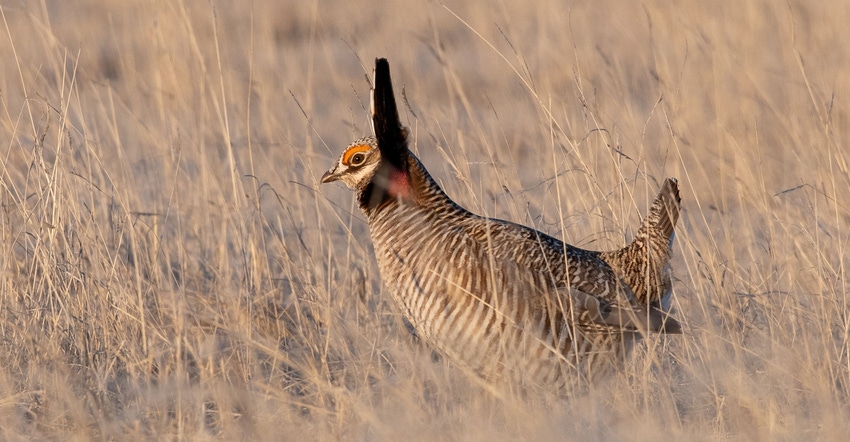
Ranchers and environmentalists are about to face off, yet again, over the lesser prairie chicken.
The U.S. Fish and Wildlife Service announced Nov. 17 it will list two distinct population segments (DPS) of the lesser prairie chicken under the Endangered Species Act. According to its release, the southern DPS of the lesser prairie chicken is being listed as “endangered.” The northern DPS of the lesser prairie chicken is being listed as “threatened.” USFWS is also finalizing a section 4(d) rule designed to conserve the northern DPS of the lesser prairie chicken while allowing greater flexibility for landowners and land managers.
“The lesser prairie chicken’s decline is a sign our native grasslands and prairies are in peril. These habitats support a diversity of wildlife and are valued for water quality, climate resilience, grazing, hunting and recreation,” said Amy Lueders, USFWS southwest regional director, in a news release. “The service continues to work with stakeholders to develop voluntary conservation agreements that will protect the lesser prairie chicken and the native grasslands on which it depends, while assuring that oil and gas and renewable energy development, ranching, agriculture and other activities continue.”
Environmental barometer tells story
While historical estimates suggest lesser prairie chickens once numbered in the hundreds of thousands — or even millions — across nearly 100 million acres, populations have declined drastically due to habitat loss and fragmentation, according to USFWS. Lesser prairie chicken habitat has diminished across its historical range by about 90%. Aerial survey results from 2012 through 2022 estimate a five-year average lesser prairie chicken population of 32,210 across the five-state region.
“The southern DPS encompasses lesser prairie chicken populations in eastern New Mexico and across the southwest Texas Panhandle,” according to the release. “Habitat in this DPS is comprised largely of shinnery oak prairie. The northern DPS encompasses lesser prairie chicken populations in southeastern Colorado, south central to western Kansas, western Oklahoma, and the northeast Texas Panhandle. Habitat in this DPS includes short-grass, mixed-grass, and sand sagebrush ecoregions.”
USFWS works to allow sustainable grazing
The USFWS has worked, and will continue to work, with partners and landowners to promote sustainable grazing practices. “The 4(d) rule for the northern DPS provides that farmers can continue their routine agriculture activities on existing cultivated land,” according to the USFWS release. “Lastly, the 4(d) rule also provides an exception for implementation of prescribed burning for grassland management.”
As part of the 4(d) rule for the northern DPS, there is an exception for producers who are following a prescribed grazing plan developed by a qualified party that has been approved by USFWS, according to its release.
It’s also working with the Natural Resources Conservation Service to provide landowners with technical and financial assistance to implement land management tools and techniques under the Working Lands for Wildlife Framework.
According to USFWS, voluntary conservation efforts have helped conserve key habitat for the birds, but they aren’t yet enough to offset the threats and reverse the trends of habitat loss.
Opposition from NCBA, Public Lands Council
The National Cattlemen’s Beef Association and the Public Lands Council announced their opposition to the USFWS final rule to list the lesser prairie chicken under the Endangered Species Act.
“Over and over, the science has proven that healthy, diverse rangelands — the exact kind of landscape maintained by livestock grazing — are where the lesser prairie chicken thrives. Cattle ranchers’ efforts to conserve these acres are absolutely critical to the survival of the species,” said Kaitlynn Glover, NCBA executive director of natural resources and Public Lands Council executive director, in a press release. “We are deeply disappointed by the Fish and Wildlife Service’s decision to impose redundant bureaucracy and punitive restrictions on the very same people that we have to thank for the lesser prairie chicken’s continued existence on the range.”
NCBA objects to the appointment of private third parties as grazing authorities in the range of the lesser prairie chicken. These could include environmental activist groups. And USFWS has stipulated that to qualify for legal protection under the 4(d) rule in the northern DPS, producers must follow a grazing management plan that’s “obtained arbitrary approval from a yet-to-be-named, FWS-approved third party.” By contrast, other agricultural practices that are listed as key factors in the USFWS decision are granted far more flexibility, they say.
“Designing a third-party verification system to empower distant bureaucrats over land managers and ranchers with decades of experience, with parameters that blatantly prioritize political objectives over sound science, effectively ensures that the only use of the 4(d) rule will be to obstruct grazing activities,” NCBA contends.
National Cattlemen’s Beef Association and the U.S. Fish and Wildlife Service contributed to this article.
About the Author(s)
You May Also Like






